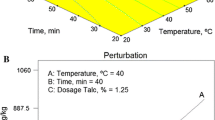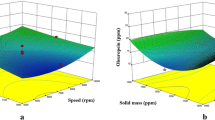Abstract
Extra-virgin olive oil is basically used in food, but it can also be used as a source of high added-value components, such as oleocanthal and oleacein. Oleocanthal and oleacein are bioactive compounds with proven activities in the treatment of various diseases. By applying response surface methodology, oils of the Arbequina, Arbosana, and Koroneiki cultivars of super-intensive olive trees have been elaborated, under both irrigation and rainfed conditions. 289 oils have been obtained and 13 parameters per oil determined, which have been grouped into 221 models, that determine extraction performance, quality, and minor components of oils. The maximum extractable olive oil with the current technology is 89.0 ± 3.9%, with the rest remaining in the pomace. Oleacein is the component that most influences the antioxidant capacity of oils; its activity is 5.85 ± 0.33 µmol Trolox/mg. Irrigated Arbequina produces very aromatic oils. Rainfed Arbequina produces less aromatic (18.5 mg/kg of volatile) but with a higher content of phenolic compounds (514.4 mg/kg) oils. Koroneiki produces oils with a very high content of phenolic compounds but low in volatiles. For Koroneiki, the factors that maximize phenolic compounds are: rainfed crops, mill with 4.5 mm sieve, and malaxation at 40 °C for 30 min (1307.2 mg/kg of phenolic compounds, witch 500.0 mg/kg of oleacein, and 174.3 mg/kg of oleocanthal). A method to extract oleocanthal and oleacein from olive oils is proposed, as a way to develop new strategies to improve their functional properties.





Similar content being viewed by others
References
Presti G, Guarrasi V, Gulotta E, Provenzano F, Provenzano A, Giuliano S, Monfreda M, Mangione M, Passantino R, San Biagio P, Costa M, Giacomazza D (2017) Bioactive compounds from extra virgin olive oils: correlation between phenolic content and oxidative stress cell protection. Biophys Chem 230:109–116. https://doi.org/10.1016/j.bpc.2017.09.002
Lopes de Souza A, Marcadenti A, Portal V (2017) Effects of olive oil phenolic compounds on inflammation in the prevention and treatment of coronary artery disease. Nutrients 9(10):1087. https://doi.org/10.3390/nu9101087
Batarseh YS, Kaddoumi A (2018) Oleocanthal-rich extra-virgin olive oil enhances donepezil effect by reducing amyloid-β load and related toxicity in a mouse model of Alzheimer’s disease. J Nutr Biochem 55:113–123. https://doi.org/10.1016/j.jnutbio.2017.12.006
Scotece M, Conde J, Abella V, Lopez V, Pino J, Lago F, Smith AB, Gómez-Reino JJ, Gualillo O (2015) New drugs from ancient natural foods. Oleocanthal, the natural occurring spicy compound of olive oil: a brief history. Drug Discov Today 20:406–410. https://doi.org/10.1016/j.drudis.2014.10.017
Agrawal K, Melliou E, Li X, Pedersen TL, Wang SC, Magiatis P, Newman JW, Holt RR (2017) Oleocanthal-rich extra virgin olive oil demonstrates acute anti-platelet effects in healthy men in a randomized trial. J Funct Foods 36:84–93. https://doi.org/10.1016/j.jff.2017.06.046
Filipek A, Czerwińska ME, Kiss AK, Polański JA, Naruszewicz M (2017) Oleacein may inhibit destabilization of carotid plaques from hypertensive patients. Impact on high mobility group protein-1. Phytomedicine 32:68–73. https://doi.org/10.1016/j.phymed.2017.06.004
Filipek A, Czerwińska ME, Kiss AK, Wrzosek M, Naruszewicz M (2015) Oleacein enhances anti-inflammatory activity of human macrophages by increasing CD163 receptor expression. Phytomedicine 22:1255–1261. https://doi.org/10.1016/j.phymed.2015.10.005
Valli M, Peviani EG, Porta A, D'Alfonso A, Zanoni G, Vidari G (2013) A concise and efficient total synthesis of oleocanthal. Eur J Org Chem 2013:4332–4336. https://doi.org/10.1002/ejoc.201300324
Costanzo P, Bonacci S, Cariati L, Nardi M, Oliverio M, Procopio A (2018) Simple and efficient sustainable semi-synthesis of oleacein [2-(3,4-hydroxyphenyl) ethyl (3S,4E)-4-formyl-3-(2-oxoethyl)hex-4-enoate] as potential additive for edible oils. Food Chem 245:410–414. https://doi.org/10.1016/j.foodchem.2017.10.097
Adhami H, Zehl M, Dangl C, Dorfmeister D, Stadler M, Urban E, Hewitson P, Ignatova S, Krenn L (2015) Preparative isolation of oleocanthal, tyrosol, and hydroxytyrosol from olive oil by HPCCC. Food Chem 170:154–159. https://doi.org/10.1016/j.foodchem.2014.08.079
Angelis A, Hamzaoui M, Aligiannis N, Nikou T, Michailidis D, Gerolimatos P, Termentzi A, Hubert J, Halabalaki M, Renault J, Skaltsounis A (2017) An integrated process for the recovery of high added-value compounds from olive oil using solid support free liquid-liquid extraction and chromatography techniques. J Chromatogr A 1491:126–136. https://doi.org/10.1016/j.chroma.2017.02.046
Espínola F, Moya M, Fernández DG, Castro E (2009) Improved extraction of virgin olive oil using calcium carbonate as coadjuvant extractant. J Food Eng 92:112–118. https://doi.org/10.1016/j.jfoodeng.2008.10.038
Espínola F, Moya M, Fernández DG, Castro E (2011) Modelling of virgin olive oil extraction using response surface methodology. Int J Food Sci Tech 46:2576–2583. https://doi.org/10.1111/j.1365-2621.2011.02786.x
European Commission Regulation (1991) Characteristics of olive oil and olive-residue oil and on the relevant methods of analysis. EEC 2568/91, L248:1–83. https://eur-lex.europa.eu/legal-content/EN/TXT/PDF/?uri=CELEX:01991R2568-20161204&from=FI
International Olive Council (2017) Determination of biophenols in olive oils by HPLC. COI/T.20/Doc. No 29. https://www.internationaloliveoil.org/wp-content/uploads/2019/11/COI-T.20-Doc.-No-29-Rev-1-2017.pdf
Vidal AM, Alcalá S, de Torres A, Moya M, Espínola F (2018) Industrial production of a balanced virgin olive oil. LWT Food Sci Technol 97:588–596. https://doi.org/10.1016/j.lwt.2018.07.054
Ferreira SLC, Bruns RE, Ferreira HS, Matos GD, David JM, Brandão GC, da Silva EGP, Portugal LA, dos Reis PS, Souza AS, dos Santos WNL (2007) Box-Behnken design: an alternative for the optimization of analytical methods. Anal Chim Acta 597:179–186. https://doi.org/10.1016/j.aca.2007.07.011
Ben Brahim S, Marrakchi F, Gargouri B, Bouaziz M (2015) Optimization of malaxing conditions using CaCO3 as a coadjuvant: a method to increase yield and quality of extra virgin olive oil cv. Chemlali LWT-Food Sci Technol 63:243–252. https://doi.org/10.1016/j.lwt.2015.03.013
Squeo G, Silletti R, Summo C, Paradiso VM, Pasqualone A, Caponio F (2016) Influence of calcium carbonate on extraction yield and quality of extra virgin oil from olive (Olea europaea L. cv. Coratina). Food Chem 209:65–71. https://doi.org/10.1016/j.foodchem.2016.04.028
Tamborrino A, Squeo G, Leone A, Paradiso VM, Romaniello R, Summo C, Pasqualone A, Catalano P, Bianchi B, Caponio F (2017) Industrial trials on coadjuvants in olive oil extraction process: Effect on rheological properties, energy consumption, oil yield and olive oil characteristics. J Food Eng 205:34–46. https://doi.org/10.1016/j.jfoodeng.2017.02.019
Moya M, Alcalá S, Ocaña MT, Vidal A, Espínola F (2018) Oil mill coadjuvants: aggregation due to moisture and action on olive-pomace oils. J Food Eng 236:51–59. https://doi.org/10.1016/j.jfoodeng.2018.05.013
Clodoveo ML (2019) Industrial ultrasound applications in the extra-virgin olive oil extraction process: history, approaches, and key questions. Foods 8:121. https://doi.org/10.3390/foods8040121
Amirante R, Clodoveo ML (2017) Developments in the design and construction of continuous full-scale ultrasonic devices for the EVOO industry. Eur J Lipid Sci Technol 119:1600438. https://doi.org/10.1002/ejlt.201600438
Andreou V, Dimopoulos G, Alexandrakis Z, Katsaros G, Oikonomou D, Toepfl S, Heinz V, Taoukis P (2017) Shelf-life evaluation of virgin olive oil extracted from olives subjected to nonthermal pretreatments for yield increase. Innov Food Sci Emerg 40:52–57. https://doi.org/10.1016/j.ifset.2016.09.009
Miho H, Díez CM, Mena-Bravo A, Sánchez de Medina V, Moral J, Melliou E, Magiatis P, Rallo L, Barranco D, Priego-Capote F (2018) Cultivar influence on variability in olive oil phenolic profiles determined through an extensive germplasm survey. Food Chem 266:192–199. https://doi.org/10.1016/j.foodchem.2018.06.002
Servili M, Sordini B, Esposto S, Urbani S, Veneziani G, Di Maio I, Selvaggini R, Taticchi A (2013) Biological activities of phenolic compounds of extra virgin olive oil. Antioxidants 3:1–23. https://doi.org/10.3390/antiox3010001
European Commission Regulation (2012) List of permitted health claims made on foods, other than those referring to the reduction of disease risk and to children’s development and health. EU 432/2012, L136:1–40. https://eur-lex.europa.eu/legal-content/EN/TXT/PDF/?uri=CELEX:32012R0432&from=EN
Motilva MJ, Tovar MJ, Romero MP, Alegre S, Girona J (2000) Influence of regulated deficit irrigation strategies applied to olive trees (Arbequina cultivar) on oil yield and oil composition during the fruit ripening period. J Sci Food Agric 80:2037–2043. https://doi.org/10.1002/1097-0010(200011)80:14%3c2037:AID-JSFA733%3e3.0.CO;2-0
García JM, Morales-Sillero A, Pérez-Rubio AG, Diaz-Espejo A, Montero A, Fernández JE (2017) Virgin olive oil quality of hedgerow ‘Arbequina’ olive trees under deficit irrigation. J Sci Food Agric 97:1018–1026. https://doi.org/10.1002/jsfa.7828
Bilušić T, Žanetić M, Ljubenkov I, Mekinić IG, Štambuk S, Bojović V, Soldo B, Magiatis P (2018) Molecular characterization of Dalmatian cultivars and the influence of the olive fruit harvest period on chemical profile, sensory characteristics and oil oxidative stability. Eur Food Res Technol 244:281–289. https://doi.org/10.1007/s00217-017-2954-7
de Torres A, Espínola F, Moya M, Castro E (2016) Composition of secoiridoid derivatives from Picual virgin olive oil using response surface methodology with regard to malaxation conditions, fruit ripening, and irrigation management. Eur Food Res Technol 242:1709–1718. https://doi.org/10.1007/s00217-016-2670-8
Ramos-Escudero F, Morales MT, Asuero AG (2015) Characterization of bioactive compounds from monovarietal virgin olive oils: relationship between phenolic compounds-antioxidant capacities. Int J Food Prop 18:348–358. https://doi.org/10.1080/10942912.2013.809542
Czerwińska M, Kiss AK, Naruszewicz M (2012) A comparison of antioxidant activities of oleuropein and its dialdehydic derivative from olive oil, oleacein. Food Chem 131:940–947. https://doi.org/10.1016/j.foodchem.2011.09.082
Vidal AM, Alcalá S, Ocaña MT, De Torres A, Espínola F, Moya M (2018) Modeling of volatile and phenolic compounds and optimization of the process conditions for obtaining balanced extra virgin olive oils. Grasas Aceites 69(2):e250. https://doi.org/10.3989/gya.1220172
Acknowledgements
The authors are grateful to the Department of Economy, Innovation, and Science of the Andalusian Regional Government, for the financial help provided through Research Project of Excellence PI11-AGR-7726. The authors would also like to acknowledge Todolivo S.L. and all their staff for their kindness and attention.
Author information
Authors and Affiliations
Corresponding author
Ethics declarations
Conflict of interest
The authors declare no conflict of interest.
Compliance with ethics requirements
This article does not contain any studies with human or animal subjects.
Additional information
Publisher's Note
Springer Nature remains neutral with regard to jurisdictional claims in published maps and institutional affiliations.
Rights and permissions
About this article
Cite this article
Vidal, A.M., Alcalá, S., Ocaña, M.T. et al. Elaboration of extra-virgin olive oils rich in oleocanthal and oleacein: pilot plant’s proposal. Eur Food Res Technol 246, 1459–1468 (2020). https://doi.org/10.1007/s00217-020-03503-1
Received:
Revised:
Accepted:
Published:
Issue Date:
DOI: https://doi.org/10.1007/s00217-020-03503-1




